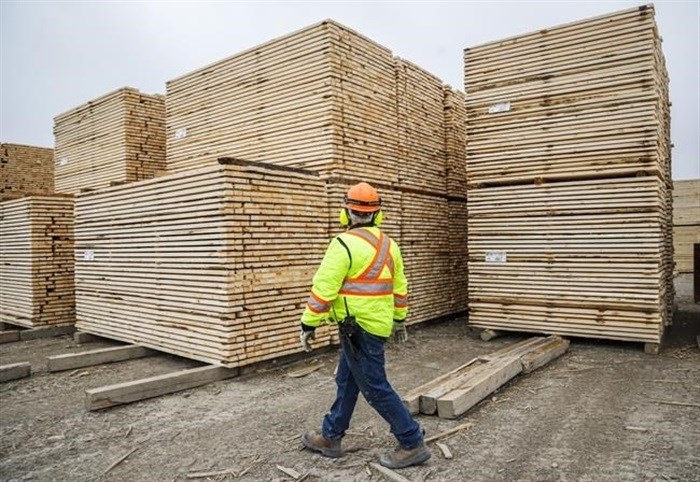
Darcy Elliott, shipping supervisor at Spray Lake Sawmills, inspects lumber at the facility in Cochrane, Alta., Thursday, May 20, 2021.
Image Credit: THE CANADIAN PRESS/Jeff McIntosh
May 30, 2021 - 12:09 PM
CALGARY - A drive to increase Alberta’s forest harvest as lumber prices hover at record heights is allowing members of a northern First Nation to become resource owners as well as timber-gathering contractors, says the leader of the Bigstone Cree Nation.
The Nation’s logging company, Bigstone Forestry Inc., was formed with the help of Alberta-Pacific Forest Industries Inc. many years ago to help supply its pulp mill near Athabasca with logs from its forest management area.
In early May, the First Nation won its own slice of Alberta forest. It now has the right to harvest 21,000 cubic metres of coniferous wood per year from previously unallocated Crown land in a remote region about 300 kilometres north of Edmonton.
"First Nations have been accused of always asking for handouts. We don't play that kind of game. We try to do what's best,” said Chief Silas Yellowknee in an interview.
An unexpected boom in demand for forest products thanks to robust housing and home renovation markets is fattening the treasury of the Alberta government.
In the recently ended 2020-21 fiscal year, the province reaped timber dues — which are adjusted monthly based on current prices — of about $350 million, more than triple the $99 million earned in the previous year and seven times the $51 million from 2015-16.
Meanwhile, the levy paid by the industry for forest improvement activities jumped to $160 million thanks to the high prices, versus $19 million in 2019-20 and a paltry $2.7 million in 2015-16.
The contribution to Alberta’s coffers is dwarfed by that of oil, gas and coal, but it helps fill the gap when those non-renewable resources fall short, as they did in the last fiscal year, dropping to about $2 billion in revenue from $5.9 billion in the previous year.
When oil prices go up, Alberta produces more oil, but that's not the case with forest products because most of Alberta's sustainable annual harvest has already been allocated.
At Spray Lake Sawmills in Cochrane, just northwest of Calgary, the company is harvesting the maximum allowed under its provincial permits, said Ed Kulcsar, vice-president of woodlands.
He remembers the global recession that forced Spray Lakes to drop from two shifts to one from 2010 to 2013, and the shock of the early COVID-19 lockdowns a year ago that temporarily erased the market for forest products and caused the company to shut down for a month.
"We're thankful for the good prices today but we're always mindful that the lumber market is very cyclical and it can go down at any time," he said. "Some people say the big cure for high lumber prices is high lumber prices."
Grande Prairie is a small northwestern Alberta city that serves as a hub for oil and gas, agriculture and forestry, with an oriented strand board (OSB) panel mill, a paper mill and two sawmills.
"In balancing the ebbs and flows of different economies, seeing the growth in forestry has really been a positive light and discussion point in our community," said Mayor Jackie Clayton, noting forestry employs about 2,300 people, supports over 160 related businesses and accounts for $900 million in local exports annually.
Norbord Inc., owner of the OSB mill, was a second recipient of provincial forest harvest rights earlier this month, winning 51,000 cubic metres per year of unallocated wood from an area about 70 kilometres northwest of Grande Prairie.
In a deal partly driven by high building product prices, Norbord became a division of West Fraser Timber Co. Ltd. in February in return for $4 billion in shares, leaving West Fraser as the largest forestry company in Alberta with 15 facilities in 13 communities and about 2,500 direct employees.
A spokeswoman for West Fraser said the new provincial wood supply "will support capital investments previously made at the Grande Prairie OSB mill," with no immediate plans for expanding production.
Alberta Forestry Minister Devin Dreeshen said he asked his department early in his current mandate to re-examine the province's forest riches "as a true environmentalist" to come up with ways to most efficiently use its bounty.
"They crunched the numbers and said about a 33 per cent increase from the annual allowable cut is something we could sustainably harvest and make sure we do preventive measures such as forest fire protection and pest management," he said in an interview.
He's now looking for ways to increase the annual harvest by as much as another 20 per cent, after increasing it by 13 per cent in the last year or so with moves including the allocations to Bigstone Cree and Norbord.
The province’s efforts have been criticized by the Alberta Wilderness Association as potentially harmful to the forest, and by the grand chief of the Treaty 8 First Nations for a lack of Indigenous consultation.
But Chief Yellowknee says he's confident his part of the forest will thrive now that his nation is a resource owner.
"This way, it being ours, it will be looked after the proper way. That's how we're looking at it."
This report by The Canadian Press was first published May 30, 2021.
Companies in this story: (TSX:WFG)
News from © The Canadian Press, 2021